This year marks the 100th anniversary of the 1912 planting of the famous flowering cherries surrounding the Tidal Basin in Washington, D.C. The story of how they came to be planted is worth exploring, given the centennial anniversary, the lasting impact of the planting efforts, and the continued public fascination with flowering cherries. Although the Tidal Basin plantings seem like a singular event, the interest in flowering cherries was widespread in the early 1900s, and these plants came into the United States through a number of different sources. Around this time both the USDA’s Office of Foreign Seed and Plant Introduction (under David Fairchild) and the Arnold Arboretum were instrumental in bringing many cultivated varieties into the United States as part of a broad interest in flowering cherries. Based largely on the efforts of Fairchild, Charles S. Sargent, and E. H. Wilson, there was a surge in the number of varieties available in the first quarter of the twentieth century.
The flowering cherries, or sakura, have been an integral part of Japanese culture for centuries. “Japanese flowering cherries” is a general term for a taxonomically complex group of plants that includes several well-known taxa such as Prunus subhirtella (Higan cherry), Prunus × yedoensis (Yoshino cherry), Prunus serrulata (also known as the Sato-zakura group) with its numerous cultivars, plus a number of other species. Despite their historic popularity in Japan, only a few types of flowering cherries had entered the United States during the latter part of the nineteenth century. The most commonly available flowering cherry at this time was probably the weeping Higan cherry (Prunus subhirtella ‘Pendula’), listed in nursery catalogues starting in the mid-1800s (Russell 1934). The earliest record of the weeping Higan cherry at the Arnold Arboretum dates from January 16, 1880, when a plant was received from Mr. A. M. McLaren of Forest Hills, Massachusetts. In 1916, Wilson wrote that weeping Higan cherry “is now a fairly familiar tree in the parks and gardens of Europe and North America” (Wilson 1916).
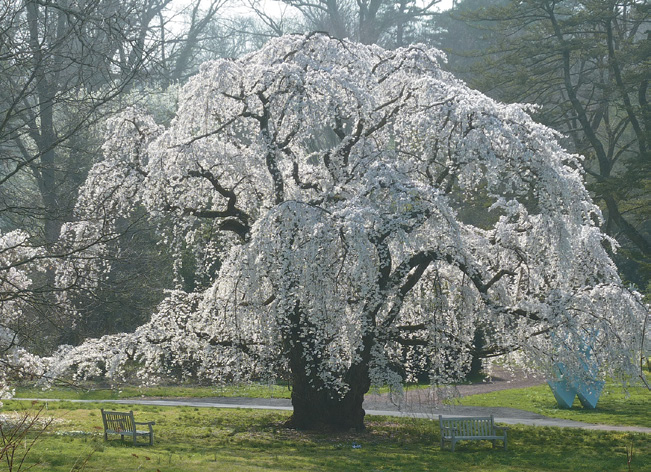

Japanese Cherries Come to America
In the late 1800s, the Arnold Arboretum was responsible for some of the first introductions of flowering cherries into North America. Prunus sargentii (previously described as Prunus serrulata var. sachalinensis) was first introduced to the Arboretum in 1890 by Dr. William S. Bigelow, who sent seeds from Japan, and again in 1892 by Charles S. Sargent on his Japanese expedition (Wilson 1916). In 1894, seeds of Higan cherry (Prunus subhirtella) were received from the Imperial Botanic Garden in Tokyo (Wilson 1916). In 1934, describing trees grown from this collection, Paul Russell of the USDA’s Division of Plant Exploration and Introduction wrote that “two excellent specimens which stand near the Forest Hills gate of the Arnold Arboretum are nearly 40 years old; the tips of their wide-spreading branches nearly touch the ground. These apparently are the oldest trees in cultivation outside of Japan and it was from the Arnold Arboretum that this variety found its way into England” (Russell 1934).
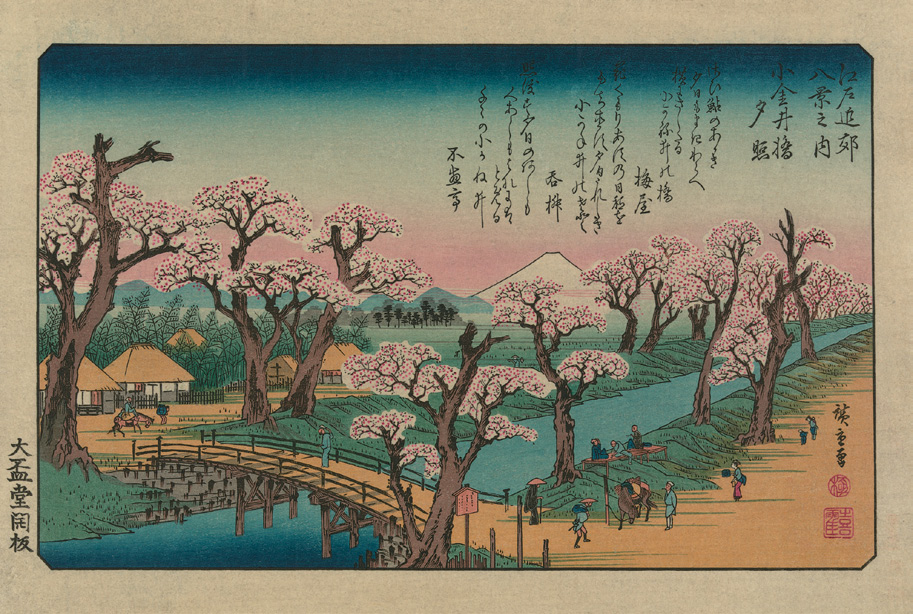
Despite these first introductions, the diversity of flowering cherries available in the early 1900s was limited. Fairchild described the situation at this time, writing, “I do not mean to give the impression that there were no flowering cherry trees in this country before the Office of Plant Introduction began to bring them in. There were individual trees brought in by naval officers and others who had learned to love them in the East, and several nursery firms handled them, but there were no mass plantings and only a few varieties were known” (Fairchild, undated manuscript).
Leading up to the 1912 planting in Washington, David Fairchild and Eliza Scidmore were perhaps the greatest proponents of planting flowering cherries. Scidmore was a remarkable woman who spent a significant amount of time in Japan, China, Java, and the Philippines as a journalist at the turn of the nineteenth century (Jefferson and Fusonie 1977). She became enamored with Japanese culture, flowering cherries in particular, and had long promoted the idea of planting these throughout Washington. Likewise, Fairchild became enthralled with flowering cherries on his 1902 visit to Japan. As a result of this trip, Fairchild, with help from philanthropist Barbour Lathrop, first imported 30 varieties of flowering cherries into the USDA system in 1903. The following year a collection of 50 varieties was imported into the Plant Introduction Station in Chico, California, although Fairchild wrote that the shipment into Chico did not grow particularly well and many of them had died (Fairchild, undated manuscript).
In 1906, Fairchild and his wife, Marian Bell Fairchild, imported 25 varieties directly from the Yokohama Nursery Company of Japan for their property, “In the Woods,” located in Chevy Chase, Maryland. One of his goals was to test these varieties for cold hardiness, which to this point was virtually unknown. This experiment was so successful that in 1908 Fairchild helped to organize an Arbor Day planting with schoolboys from every school in Washington, with each of them receiving a flowering cherry to plant in schoolyards across the city (Jefferson and Fusonie 1977).


In the often told story (Jefferson and Fusonie 1977; McClellan 2005), the first donation of flowering cherries sent to Washington from the City of Tokyo was found to be heavily infested with insects and diseases. All 2,000 trees were burned and, as can be imagined, this created a great deal of diplomatic consternation. Fortunately this was all overcome and a second shipment of 6,000 insect- and disease-free trees reached the United States in 1912. One half of these were sent to New York City, where some of the original Yoshino cherries grow near the reservoir in Central Park. The better known half of this shipment were the 3,020 trees that were sent to Washington and were planted around the Tidal Basin, on the White House grounds, and in other areas in the city, where they quickly made the capital famous for its cherry blossom displays. These original trees were made up of 11 varieties of Prunus serrulata (1,220 plants) and 1,800 plants of Yoshino cherry (Prunus × yedoensis) (Jefferson 1995). Today, of the 3,750 total trees counted by the National Park Service, Yoshino and Kwanzan (Prunus serrulata ‘Kwanzan’) cherries predominate (http://www.nps.gov/ cherry/index.htm).
Soon after these plantings, E. H. Wilson conducted his 1914 plant collecting expedition to Japan. This expedition focused on cultivated plants and, because it was to be a less rigorous trip, Wilson was accompanied by his wife and daughter (Howard 1980). This trip is often overshadowed by Wilson’s more famous expeditions but it is remarkable for his investigation and importation of Japanese flowering cherries. One of the main purposes of this expedition was to assemble a collection of authentic, named Japanese flowering cherries, backed up by herbarium specimens and published taxonomic descriptions. One of the lasting results of the expedition was the publication of Wilson’s seminal work on the subject, Cherries of Japan. Wilson’s nomenclature can be confounding at times, but the book marked the first publication in English of a thorough review of these plants.
A Flood of Flowers
In early 1915, a large shipment of over 60 varieties arrived at the Arnold Arboretum directly from the Yokohama Nursery Company. Additionally, scion wood of 63 varieties was sent for propagation directly to the USDA in January 1915, under a cooperative agreement between the USDA and the Arnold
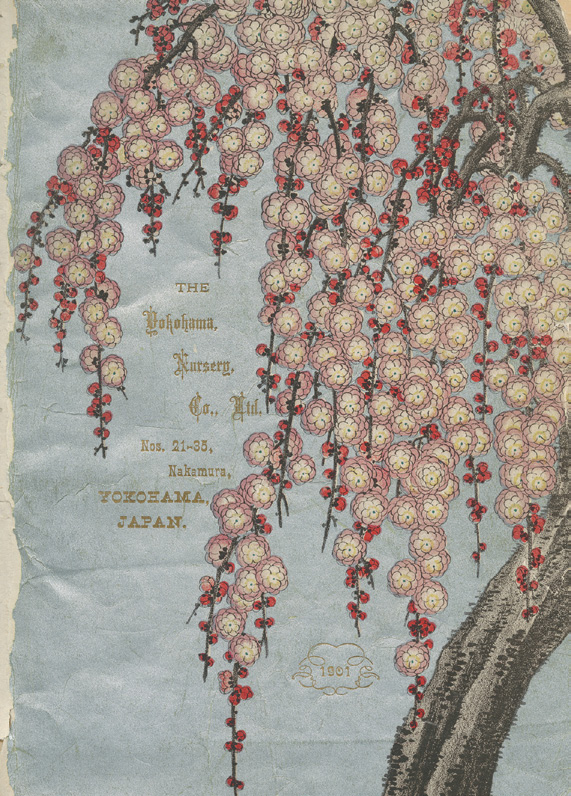
Arboretum. Unfortunately many of these were not successfully propagated, so in February 1916 a duplicate set of 54 varieties was “presented by the municipality of Tokyo to the American Government. These scions were cut from authentic trees growing in the famous Arakawa flowering-cherry collection maintained by the Tokyo municipality, which collection … contains some of the loveliest forms of these remarkable flowering trees” (Fairchild 1916). Another famous plant explorer, Frank N. Meyer, along with Mr. H. Suzuki of the Yokohama Nursery Company, was instrumental in arranging this second shipment. Fairchild wrote that “so much and such genuine interest has been aroused in the Japanese flowering cherry trees, through the gift to the City of Washington by the Mayor of Tokyo of a collection of them, and through the satisfactory growth which specimen trees have made in Maryland, Massachusetts, and California, that a demand for them has grown up which nurserymen find it difficult to meet. It is of interest, therefore, to point out that 54 varieties from the municipal collection of Tokyo near Arakawa, which represent the loveliest of the hundreds of varieties known to the Japanese, have been secured through the Mayor’s courtesy, and these will be propagated and distributed under the same varietal names as they bear in the Arakawan collection” (Fairchild 1917).
It may seem heretical to us today, given current concerns over invasive plants and pests, but at the time it was possible to purchase a wide range of plants directly from overseas. Yokohama Nursery Company catalogues from this era list a large assortment of single, double, and semi-double flowering cherry varieties. It is possible to gain insight into this trade from institutional and private records. For example, our records at the Morris Arboretum indicate that co-founder John Morris purchased weeping Higan cherries from the Yokohama Nursery Company in 1910 and Yoshino and Mt. Fuji (Prunus serrulata ‘Shirotae’) cherries from the same source in 1912.
Flowering cherries continued to be very popular between the World Wars. One of the leading proponents and sources of flowering cherries was Anton Emile Wohlert, the proprietor of the Garden Nurseries in suburban Philadelphia (Wister 1955–56). Information about Wohlert is scarce and comes indirectly through his nursery catalogues and the plant records of Philadelphia arboreta. Wohlert promoted all forms of Prunus, including his own introductions named after family members. As far as I can tell, all of these cultivars are extinct from cultivation so we will never know if they were as exemplary as Wohlert claimed.
During the pre-World War II period the USDA continued their great interest in flowering cherries, with the mantle passed on to Paul Russell, whose 1934 publication The Oriental Flowering Cherries remains one of the most useful works on this group of plants. In the late 1920s and 1930s Russell continued the tradition of importing cherries into the germplasm system, most significantly plants he propagated from the Fairchild estate in Chevy Chase. Russell had the advantage of examining thirty years of growth and establishment of Prunus, and his work provides an invaluable insight into the state of development in the early 1930s. In this booklet Russell mentions the most important cherry collections, including those at the Plant Introduction Gardens in Glenn Dale, Maryland, and Chico, California, along with those at the Arnold Arboretum and the city parks of Rochester, New York.

No article on flowering cherries is complete without mention of Captain Collingwood “Cherry” Ingram, a British horticulturist who was one of the most well-known plantsmen of his time. Among many diverse interests, Ingram dedicated himself to importing, growing, and hybridizing flowering cherries (Buchan 2011). His 1948 book, Ornamental Cherries, was responsible for spreading the gospel of growing cherries both in the United Kingdom as well as on the Continent (Ingram 1948). If you happen to visit the Philadelphia Flower Show or tour the city in mid-March, you will unwittingly owe a great debt to Captain Ingram because one of the most dominant trees at the show and on the streets at that time of year is Prunus ‘Okame’, an Ingram hybrid cherry with early-blooming light pink flowers. It was imported into the United States through the Morris Arboretum by Henry F. Skinner. This plant grew in relative obscurity here until the early 1980s, when propagation and distribution made it a popular nursery choice (Meyer and Lewandowski 1985)
Rejuvenating Flowering Cherries at the Morris Arboretum
Like many arboretum collections, the Prunus collection at the Morris Arboretum reflects changes in horticultural trends. Our cherry collection is comprised of venerable old specimens, young trees growing vigorously, and newly added plants. In addition to trees dating to the Morris Estate era, there were continual waves of cherry varieties accessioned from the 1940s through the 1980s. In the 1940s we received a large consignment of trees from the Scott Arboretum, including a few that remain today. These were followed by a group of plants from Kingsville Nursery in the late 1950s, from Princeton Nurseries in the mid-1960s, and more cultivars from the U.S. National Arboretum in 1983.
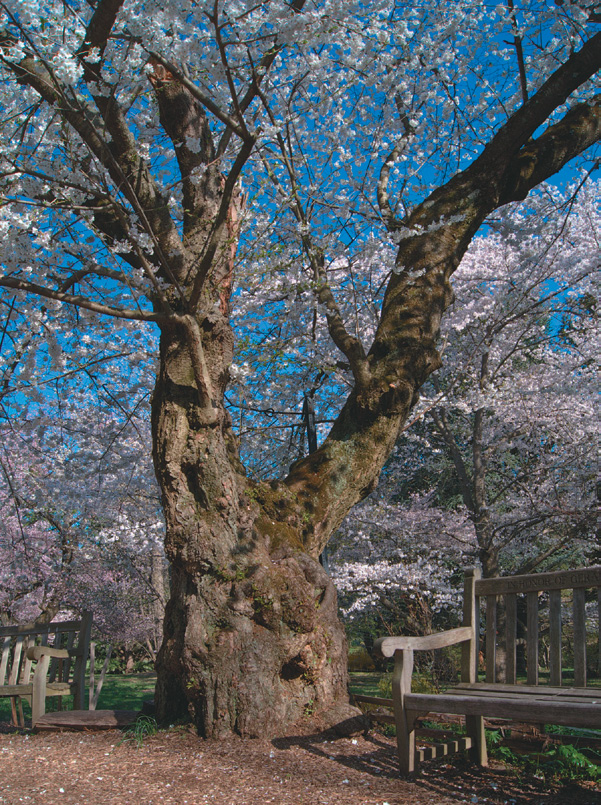


One often reads that cherries are short-lived, surviving for not more than 50 or 60 years, so it may be surprising to learn that we have cherry trees that were planted by John and Lydia Morris prior to the establishment of the Morris Arboretum in 1932. Our collection has individuals up to 100 years old because we use specific management practices for veteran trees. We work with the natural life cycles of these trees, managing them for longevity and safety and rethinking our approach to arboricultural practices.
By implementing the practices of veteran tree care, we have been able to prolong the lives of our old flowering cherries almost indefinitely (Fay 2002). I could say that we began this process through careful literature research and a prescient understanding of veteran tree biology, but the reality is more serendipitous than that. In the early 1980s, then Morris Arboretum curator Paul Meyer (now our director) began to rejuvenate our Prunus collection by removing older trees and replanting with newly propagated plants that we had received from the National Arboretum. A 1940s accession of Prunus × yedoensis ‘Daybreak’, thought to be nearing the end of its life, was pruned hard to make way for some of these youngsters. This Yoshino cherry cultivar responded remarkably well, with vigorous new growth where it had been pruned. This practice of hard pruning was then tried on more of our mature cherry trees, with very similar results.
What began as trial-and-error attempts has evolved into a regular retrenchment or restoration pruning program, based on the ideas established in Europe for veteran tree management (Fay 2002). We begin the process of targeted pruning by reducing the end-weight of declining and decaying older branches. Major portions of these branches are removed, lessening the end-load on these branches and reducing the risk of failure along with hazards to the public and staff. Simultaneously, we selectively encourage young shoots from along the interior portions of the trunk, working with the natural growth patterns of these veteran trees. Through this process of phased reduction, we continue to reduce the major structural branches, leaving the young interior branches to develop and mature into the new architecture of the tree (Fay 2002). This is an ongoing process, and we rotate through the cherry collection on a five to seven year cycle. In essence we are coppicing the trees, maintaining them in a state of juvenility and not allowing them to reach the ultimate stage of maturity and decline (Del Tredici 1999). It is illustrative to look at Japanese books on flowering cherries to learn that propping and pruning of ancient trees is a long-established cultural practice resulting in the long-lived cultural icons so revered in that country (Sano 1990).
A remarkable example of this process is one of the Yoshino cherries purchased by John Morris from the Yokohama Nursery Company in 1912. This tree grows in relative obscurity in the English Park section of the Arboretum, and it was not until recently that we pieced together historical documents and realized its origin as one of the 1912 plants. This tree has also been sustained through our veteran tree management techniques, with crown reduction and encouraging of interior growth. In addition to its massive old trunk, there are numerous basal and trunk sprouts—rather than thinking of these as detriments, we work with the tree biology, thinning and selecting this new growth with the intention of making those shoots the future crown of the tree.
On some specimens we will encourage these basal sprouts into new trees, but only if we know that the plant is on its own roots. A prime example of this is an old specimen of Prunus subhirtella ‘Pendula’ that was planted prior to 1932. This tree has a highly decayed trunk with a band of healthy bark and one large remaining branch. For the past few years we have removed all but about five of these sprouts and are encouraging the basal rejuvenation of these to form a new tree (Fay 2002). Eventually we will remove all but one or two of these and then allow the original trunk to decay completely.




Cherries have an especially interesting biology because of their tendency for endocaulous rooting, a process of forming roots from portions of stem tissue; these roots result in a successional trunk as they grow down through the decaying parent trunk (Fay 2002; Liu and Wang 1992). As the inner trunks of older plants decay, often there is a shell of living tissue surrounding a core of rich decomposed organic matter from the old wood. The tree often initiates roots into this rich medium, and as root tissue grows down through the core of the tree, it provides added structural support to the tree’s upper portions (Jenik 1994). This process is especially apparent in old flowering cherries, and an extreme example occurred with another of our old Prunus subhirtella ‘Pendula’ plants, in this case a plant that is shown on our 1909 Atlas of Compton (the Morris Estate). In the mid 1990s this tree was in significant decline, with a severely decayed old trunk supporting a few feeble branches. For a number of years we observed a major root growing within a cavity in the trunk and leafy shoots arising from the top of this root with increasing vigor. With each passing year the root became more trunklike as the old trunk further deteriorated until it was a standing hollow shell. In the fall of 1997, the old rotting trunk simply fell to the ground under its own weight. We were delighted to see that the “new tree” that had formed inside of this shell was strong enough to stand on its own, but with about four feet of above-ground root tissue forming the new trunk. Since then this tree has continued to prosper, a Lazarus of a plant having returned from the brink. It now grows vigorously across from our visitor center, providing a fabulous spring display.
Future Efforts with Flowering Cherries
A few years ago I began to expand the Morris Arboretum’s cherry collection by propagating early- and late-flowering varieties to extend the period of flowering interest. Before this project began I was intimidated by Prunus propagation, believing that, like many other rosaceous plants, they had to be grafted or budded to be reproduced. Fortunately our propagator, Shel ley Dillard, disabused me of this notion and we regularly root cuttings of a number of Prunus species and varieties (see page 14).
This project has evolved, and in recent years I have begun to survey public gardens in the northeastern United States to determine the extent of their Prunus holdings and to discover where there are unique cultivars. The goal is to propagate these and then redistribute them to a wider audience of public gardens and private collectors. Two notable examples are Prunus serrulata ‘Gyoiko’ and ‘Jo-nioi’, both represented by single trees, the former at the Morris Arboretum and the latter at the Arnold Arboretum. Last year we rooted cuttings of these and look forward to growing and distributing them. ‘Gyoiko’ is an especially interesting plant because it has chartreuse flowers with thin pink and white streaks in the center of the petals. The name translates as “colored court-robes” and refers to the green, white, and purple robes of women in the ancient Japanese imperial court (Kuitert 1999). In the original 1912 Washington planting, all 20 specimens of ‘Gyoiko’ were planted at the White House. ‘Jo-nioi’ (“supreme scent” or “first-class fragrance”) has single white flowers that bloom in profusion and is known as one of the most fragrant of the flowering cherries (Kuitert 1999). Although once more commonly grown, it has vanished from our landscapes and would make a fine addition to any garden.

The flowering cherries at the Morris Arboretum are a prime example of how a living collection can fulfill multiple aspects of our mission, namely, collections preservation, horticultural display, research, and education. The cherry collection is a model for preserving our horticultural heritage while providing a living laboratory to implement the practices of veteran tree care.
Flowering cherries have long been a captivating presence in Japan and—since their widespread introduction 100 years ago—throughout the United States as well. Their continued popularity is seen in the numerous blossom festivals across North America. The ephemerality of their blossoms provides the highlight of spring and, as the famous Japanese poet Kobayashi Issa wrote, “There is no stranger under the cherry tree …”. Plant one in your garden and see what happens.
Sidebar | Cherries in Print
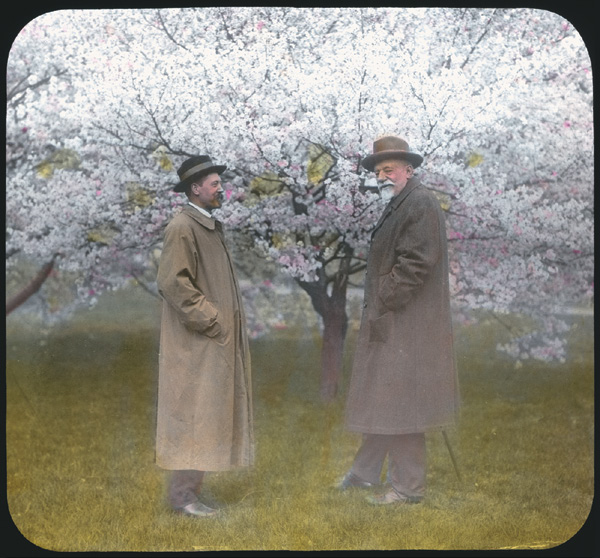
An indication of the popularity of flowering cherries can be gained by reviewing the Arnold Arboretum’s Bulletin of Popular Information and its successor, Arnoldia (Del Tredici 2011). Flowering cherries were mentioned as early as 1911, and their virtues were extolled regularly from the 19-teens through the 1930s (for examples, see Bulletin of Popular Information: New Series, Vol. III (3) May 14, 1917: pp. 9–12; Series Three, Vol. II (4) May 3, 1928: pp. 13–16; and Series Four, Vol. VI (6) May 20, 1938: 27–30). Interest in Japanese flowering cherries continued after World War II but slowly waned as the century progressed. Donald Wyman’s article, The Better Flowering Cherries, is the last holistic view of the group (Wyman 1950), after which most of what is written is restricted to only a few species and their varieties (Arnold Arboretum 1970; Arnold Arboretum 2000).
E. H. Wilson in the Bulletin of Popular Information, May 3, 1928:
The Rosebud Cherry (Prunus subhirtella pendula [P. s. ‘Pendula’]) is another sport and this, on account of its pleasing habit of growth, was one of the first trees brought to this country from Japan. Another Cherry belonging to this group is Prunus subhirtella autumnalis [P. s. ‘Autumnalis’], a small tree with many twiggy branches and more or less vase-shaped when young. It is a precocious plant with semi-double pink blossoms, which sometimes appear in the autumn but in other years sparsely in autumn and abundantly the next spring as is the case this year. Owing to this peculiarity, it is known when it flowers in the autumn as the Jugatsu-zakura or October-flowering Cherry and in the spring as the Yaye-higan or Double-flowered Spring Cherry.
Sidebar | Propagating Prunus
Our technique involves taking 4- to 6-inch-long terminal cuttings in mid-June when the trees have set terminal buds but the new growth is still somewhat flexible. We wound the cuttings, then dip in 3,000 ppm KIBA in liquid. The cuttings are stuck in a 60:40 mixture of perlite:peat to which RootShield granules (a biological fungicide containing Trichoderma harzianum) are added. The cutting trays are placed in a fog and mist greenhouse with bottom heat of 70°F (21°C) and 16-hour extended photoperiod. Although it varies from year to year and by cultivar, with this method we have very good rooting percentages with a number of cultivars. A critical step in succesful propagation is leaving the cuttings in their potting trays for the subsequent winter after they have been rooted, repotting them only when they start to show new growth the following spring.
Citations
Arnold Arboretum. 1970. A Cumulative Index to Arnoldia, Volumes 1–29 (1941–1969). Arnoldia 30(7): 63–64.
Arnold Arboretum. 2000. A Cumulative Index to Arnoldia, Volumes 1970–2000. Arnoldia 60(5): 18–19.
Buchan, U. 2011. Collingwood Ingram (1880–1981). The Plantsman (New Series) 10(3): 194–199.
Del Tredici, P. 1999. Aging and Rejuvenation in Trees. Arnoldia 59(4): 10–16.
Del Tredici, P. 2011. One Hundred Years of Popular Information. Arnoldia 69(2): 2–10.
Fairchild, D. 1916. United States Department of Agriculture, Bureau of Plant Industry Inventory of Seeds and Plants Imported 46 (Nos. 41685 to 42383): 25–26.
Fairchild, D. 1917. United States Department of Agriculture, Office of Foreign Seed and Plant Introduction: Plant Immigrants 134 (June): 1186.
Citation: Aiello, A. S. 2012. Japanese flowering cherries—A 100-year-long love affair. Arnoldia, 69(4): 2–14.
Fairchild D. Undated manuscript. Courtesy of Nancy Korber, Librarian/Archivist, Center for Tropical Plant Conservation, Fairchild Tropical Botanic Garden, Miami, FL.
Fay N. 2002. Environmental Arboriculture, Tree Ecology and Veteran Tree Management. The Arboricultural Journal 26(3): 213–238.
Howard, R. 1980. E. H. Wilson as a Botanist (Part II). Arnoldia 40(4): 154–193.
Ingram, C. 1948. Ornamental Cherries. London, Country Life.
Jenik, J. 1994. Clonal Growth in Woody Plants: A Review. Folia Geobotanica et Phytotaxonomia, Prague 29: 291–306.
Jefferson, R. 1995. The History of the Cherry Blossom Trees in Potomac Park. Introducing Modern Japan IV: 33–40.
Jefferson, R. and A. Fusonie. 1977. The Japanese Flowering Cherry Trees of Washington, D.C.: a Living Symbol of Friendship. Washington: Agricultural Research Service, U.S. Dept. of Agriculture, U.S. National Arboretum Contribution No. 4.
Kuitert, W. 1999. Japanese Flowering Cherries. Portland, OR: Timber Press.
Liu, Q and Z. Wang. 1992. Root System Inside Heartrot Stem of Betula ermanii. Research of Forest Ecosystems 6:68–71 (in Chinese).
McClellan, A. 2005. The Cherry Blossom Festival: Sakura Celebration. Boston: Bunker Hill.
Meyer, P and R. Lewandowski. 1985. The ‘Okame’ Cherry. Arnoldia 45(1): 23–24.
Russell, P. 1934. The oriental flowering cherries. Washington, [Govt. Print. Off.], U. S. Dept. of Agriculture. Circular no. 313.
Sano Tōemon. 1990. Sakura Taikan. Kyōto-shi: Satō Tōemon.
Wilson, E. H. 1916. The Cherries of Japan. Cambridge: Harvard University Press. Publications of the Arnold Arboretum No. 7
Wister, J. 1955–56. Swarthmore Plant Notes; a Record of all the Plants Grown by the Arthur Hoyt Scott Horticultural Foundation, Swarthmore College. 3rd Edition. Swarthmore.
Wyman, D. 1950. The Better Oriental Cherries. Arnoldia 10(3): 17–24.
Anthony S. Aiello is the Gayle E. Maloney Director of Horticulture and Curator at the Morris Arboretum of the University of Pennsylvania in Philadelphia, Pennsylvania.
From “free” to “friend”…
Established in 1911 as the Bulletin of Popular Information, Arnoldia has long been a definitive forum for conversations about temperate woody plants and their landscapes. In 2022, we rolled out a new vision for the magazine as a vigorous forum for tales of plant exploration, behind-the-scenes glimpses of botanical research, and deep dives into the history of gardens, landscapes, and science. The new Arnoldia includes poetry, visual art, and literary essays, following the human imagination wherever it entangles with trees.
It takes resources to gather and nurture these new voices, and we depend on the support of our member-subscribers to make it possible. But membership means more: by becoming a member of the Arnold Arboretum, you help to keep our collection vibrant and our research and educational mission active. Through the pages of Arnoldia, you can take part in the life of this free-to-all landscape whether you live next door or an ocean away.

